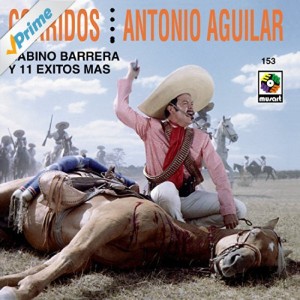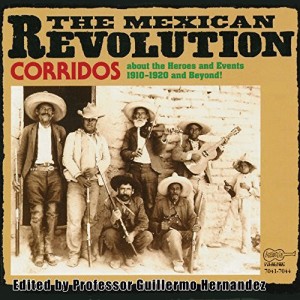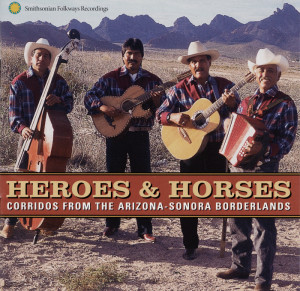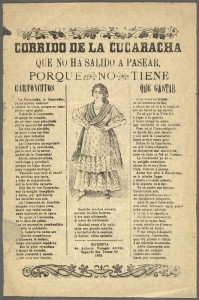 (click on the graphic to get a larger image)
(click on the graphic to get a larger image)
“The corrido is a Mexican folk ballad that stems from the romance español, a long, often epic ballad introduced by the Spanish colonizers. It’s transformation into a distinct Mexican form occurred during Mexico’s struggle for independence in the early nineteenth century”. –Helena Simonett, in BANDA: MEXICAN MUSICAL LIFE ACROSS BORDERS
There is one answer for you. Other writers note that the corrido is derived from a combination of Spanish song styles, not just the romance. Corridos were quite popular during the Mexican American War and reached even greater heights of popularity during the Mexican Revolution. A typical corridista would stand on street corners and sing to the passersby, often distributing the songs on “hojas” or leaves of large pieces of colored paper (referred to in English as broadsides). While some scholars such as Vicente Mendoza argue that the true form died out after the Revolution, others stress that the corrido has merely evolved, and that it flourishes to this day.
Corridos can be written about any number of topics. Some of the more popular corridos are about the Mexican Revolution, its heroes and villains, and the great battles that were fought. Others are about places, or about people who get themselves into trouble for being too bold or stubborn. There are also corridos about horses, cock fighting, and drug running. The latter are called narcocorridos, and they are extremely popular today.
 According to the Mexican scholar Vicente Mendoza, a typical corrido usually contains some of the following elements: the initial call of the corridista or the balladeer to the public, sometimes called the formal opening; the stating of the place, date and name of the protagonist of the ballad; the arguments of the protagonist; the message; the farewell of the protagonist; and the farewell of the corridista. (Mendoza, Vicente. La Lirirca Narrativa de Mexico, pp17-18, 1964). Of course, not all corridos follow this formula to the letter, but most corridos do include a closing or farewell message of one kind or another.
According to the Mexican scholar Vicente Mendoza, a typical corrido usually contains some of the following elements: the initial call of the corridista or the balladeer to the public, sometimes called the formal opening; the stating of the place, date and name of the protagonist of the ballad; the arguments of the protagonist; the message; the farewell of the protagonist; and the farewell of the corridista. (Mendoza, Vicente. La Lirirca Narrativa de Mexico, pp17-18, 1964). Of course, not all corridos follow this formula to the letter, but most corridos do include a closing or farewell message of one kind or another.
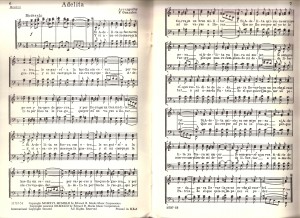 La Adelita (Click on graphic to enlarge)
La Adelita (Click on graphic to enlarge)
Simonett states that, “the corrido is usually sung in 2/4 or 3/4 time, and that its harmony is based on the tonic, dominant and subdominant chords. It is usually constructed of a number of stanzas of four or six octosyllabic lines, and the melodic phrases are repeated for each stanza. Occasionally, the corrido has a melodic refrain, which may be in a different rhythm”. (Simonett, Helena. Banda: Mexican Musical Life Across Borders, 2001).
I grew up listening to El Corrido del Caballo Blanco from the time I was 2. The song opens with the sound of a galloping horse. Anyone who hears that sound who is familiar with Mexican music, recognizes it almost immediately as being the opening to one of Jose Alfredo’s most popular songs.
When I was in my early teens, our local drugstore, El Campo Drugs on the corner of 22nd and Country Club, had a record bin with Mexican albums. One day I asked my mom to buy me one. She liked Mexican music a lot, so it wasn’t hard to convince her. I chose Antonio Aguilar’s album, Corridos. It included some of the most famous corridos ever written, such as Gabino Barrera, Juan Charrasqueado, El Hijo Desobediente, and Rosita Alvirez.
In high school, I learned more about Mexican popular music in a class called “Cultural Awareness”, one of the very first Chicano Studies classes (1974) ever offered in Tucson. Our teachers brought record albums to the classroom that included corridos of the Mexican Revolution. Songs like La Adelita and Valentin de La Sierra (see Ana Gabriel’s version below) resonated with me. They alluded to a history I was not yet familiar with, but was closer to me than I realized. My own grandparents had immigrated to the U.S. both during and after the Mexican Revolution. Their lives were directly impacted by this conflict. It took me a while to realize what this really meant to me.
I began to slowly collect record albums in high school, although I didn’t have a strong interest in Mexican music until after I graduated from college and joined KXCI radio in 1983 as a volunteer disc jockey. At that point, I started hosting two radio shows. One was a three hour morning program, and the other was a specialty program called The Chicano Connection. My goal in doing this was to present both American and Latin music to the public. Once I started listening to and collecting more music in Spanish, particularly Mexican folk music, I started to become more familiar and comfortable with the corrido repertoire, and I began to collect songbooks, albums and whatever else I could find. One artist, whose song Doña Elena y El Francés, was one of my uncle’s favorites, was the great actor Ignacio Lopez Tarso. He issued two albums of corridos of the Mexican Revolution. They are comprised of spoken word monologues accompanied by music. Here’s an example.
I have discovered over time that there are a variety of types of recordings of corridos. Some would argue that the only ones that are “authentic” and worth listening to are those that were recorded in the early part of the 20th century, or “in the field” so to speak, by folklorists. These are performed generally by working musicians, who may or may not possess the best voices. They appeal to me on a different level than those recordings that are considered more commercial, and which are quite frankly more readily accessible to the general public. (Below, however, is one set of recordings that were made in the early 20th century that is readily available from Arhoolie Records).
Another recording, one that has the feel of a field recording, but was actually recorded in 2002 , is titled, Heroes and Horses: Corridos from the Arizona Sonora Borderlands. It is also readily available from Smithsonian Folkways. It was compiled by James Griffith, folklorist and co-founder of Tucson Meet Yourself.
Some of Mexico’s greatest ranchera singers, including Miguel Aceves Mejia, Lola Beltran, Lucha Villa and Antonio Aguilar, have helped preserve the corrido by recording them on their albums. Aguilar, for example, has issued several corrido albums, including one about the Mexican Revolution and another one all about horses.
Here’s one more corrido, this time by Lucha Villa. It’s called El Hijo Desobediente.
One of my all time favorite albums of corridos is Amparo Ochoa’s recording, Corridos y Canciones de la Revolucion Mexicana, which was issued in 1983. It includes definitive versions of La Adelita, El Soldado, and Valentin de la Sierra. It also includes a very moving song called La Caritina, written by Victor Cordero, a contemporary composer. The song is about a female revolutionary colonel who fought alongside Pancho Villa, but who was not officially recognized by the Mexican government, and who ends up dying in abject poverty. Here’s Amparo Ochoa singing this song live.
Since the 1970s, narcocorridos have been very popular with the Mexican public. A wildly popular group called Los Tigres Del Norte are largely responsible for popularizing this type of corrido. Other artists such as Chalino Sanchez helped further the form’s popularity.
Corridos continue to be written to this day. Many are political or deal with current events and contemporary issues. Below is an example of a relatively new corrido about President Obama. It was recorded in 2008 by Los Dorados Del Norte. Youtube is a great source for finding these songs. There even exist corridos about Hillary Clinton and Donald Trump, some of which are very biting and funny. I’ll leave it to you the reader to explore these on your own. Have fun!
Locally, corridos are very popular in Southern Arizona. Back in the 1980s, a local group called Mariachi America, led by Gilbert Velez, recorded “El Corrido de Tucson”. Tucson Meet Yourself has also held corrido contests for many years, and the University of Arizona Poetry Center has sponsored a number of contests for high school students. Below is an example of such a corrido, written and sung by Araceli Valenzuela. The corrido won the 2010 Bilingual Corrido contest. Alfredo Valenzuela is a local teacher, now retired, who created the youth mariachi program at Davis Elementary School.
Below is a list of books you can read to learn more about the corrido. Those available online are linked to Amazon. Local libraries such as the University of Arizona Library, Pima Community College LIbrary, and the Pima County Public LIbrary also have some materials.
- Chew Sanchez, Martha I. Corridos in migrant memory. Albuquerque: University of New Mexico Press, 2006.
- Dickey, Dan William. The Kennedy Corridos: A Study of the Ballads of a Mexican American Hero. Austin: The University of Austin Center for Mexican American Studies, 1978.
- Herrera-Sobek, Maria. The Mexican corrido: a feminist analysis. Bloomington: University of Indiana Press, 1990.
- Mendoza, Vicente T. El Corrido Mexicano. Mexico: Fondo de Cultura Economica, 1954 (2004).
- Paredes, Americo. With his pistol in his hand: a border ballad and its hero. Austin: University of Texas Press, 1958.
- Wald, Elijah. Narcocorrido: a journey into the music of drugs, guns, and guerrillas. New York: Harper Collins, 2001.
Here are a few corrido recordings that are available for sale online via Amazon.
- The Mexican Revolution: Corridos. These recordings are from the early 20th century. They are considered some of the most authentic corrido recordings available.
- Antonio Aguilar: Corridos Famoso, 15 Exitos
- Miguel Aceves Mejia: Corridos y Caballos Famosos
- Los Hermanos Zaizar: Cantares de la Revolucion
- Lucha Villa: Sus Grandes Corridos
- Heroes and Horses: Corridos from the Arizona Sonora Borderlands
